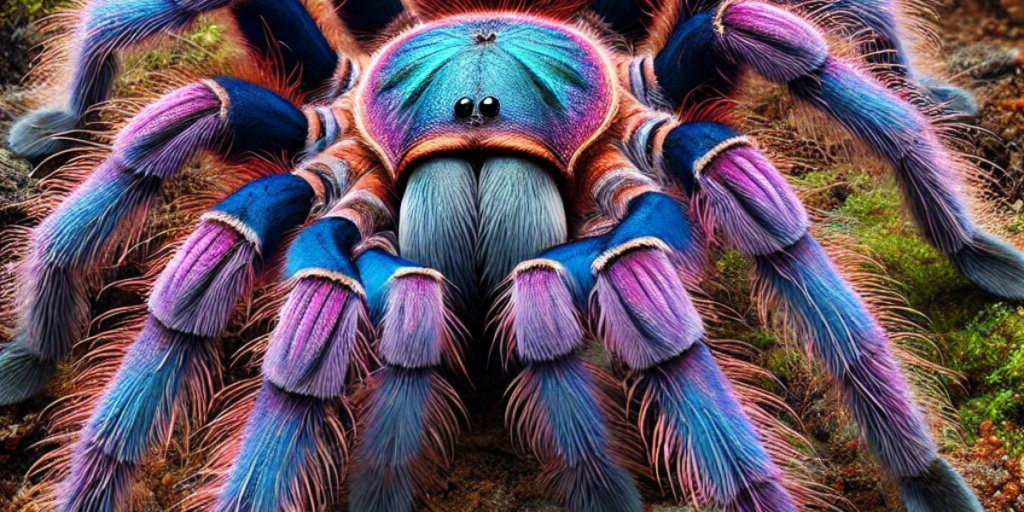Step into the enchanting world of tarantulas, where vibrant colors and fascinating behaviors converge in a realm rarely seen by most. Among these arachnid wonders, one species stands out with its striking hues and captivating charm—the Indian Violet Tarantula. Known scientifically as *Chilobrachys*This remarkable creature is not just a feast for the eyes; it’s a testament to nature’s artistry and resilience. In this blog post, we invite you on an exciting journey to uncover the secrets of the Indian Violet Tarantula. From its unique habitat in India to its intriguing care requirements for enthusiasts, join us as we delve deep into what makes this species both extraordinary and essential within the tapestry of our planet’s biodiversity! Get ready to be amazed—let’s explore together!
Introduction to the Indian Violet Tarantula
The Indian Violet Tarantula, scientifically known as Chilobrachys species, captures the imagination of arachnid enthusiasts and casual observers alike. With its striking hues and intriguing behaviors, this spider is more than just a fascinating creature; it’s a window into the rich biodiversity of India. If you’re curious about what makes this tarantula so special, join us on an exploration that uncovers its history, unique adaptations, and much more. From their habitats to conservation efforts, there’s plenty to learn about these remarkable spiders that thrive in the shadows of our natural world. Let’s dive deeper into the life of the Indian Violet Tarantula!
History and Taxonomy of Chilobrachys Species
The Chilobrachys genus has captivated arachnologists since its discovery. This group is primarily found in Asia, with a significant concentration in India and Southeast Asian countries.
Taxonomically, it belongs to the family Theraphosidae. This classification places it among some of the most recognized tarantula species globally. The name “Chilobrachys” translates to “small arms,” referencing their slender appendages.
Within this genus, numerous species exist, each displaying unique traits and habitats. Researchers continually work on refining classifications as new discoveries emerge from diverse environments.
Historical records show that these tarantulas were initially overlooked due to their elusive nature. However, growing interest in exotic pets has highlighted their beauty and fascinating behaviors within both scientific circles and among hobbyists alike.
Physical Characteristics and Behavior of the Indian Violet Tarantula
The Indian Violet Tarantula is a striking creature, notable for its captivating coloration. Its body features shades of deep violet and dark brown, giving it a regal appearance that mesmerizes enthusiasts.
These spiders can grow to an impressive size, with leg spans reaching up to six inches. Their robust builds make them formidable hunters in their natural habitat.
Behaviorally, the Indian Violet Tarantula exhibits both curiosity and caution. They are known for their burrowing tendencies, creating elaborate tunnels where they spend much of their time hidden from view. When threatened, these tarantulas display defensive posturing instead of aggression.
They have a unique way of hunting; often ambushing prey rather than actively chasing it down. This strategy aligns perfectly with their stealthy nature in the wild. With complex behaviors and vibrant looks, this species continues to fascinate arachnid lovers everywhere.
Habitat and Distribution of Chilobrachys Species
The Indian Violet Tarantula primarily inhabits the dry, deciduous forests of India. They thrive in regions with warm climates and can often be found under rocks or amongst leaf litter. These environments provide essential shelter and hunting grounds.
Chilobrachys species are not exclusive to one specific area. Their distribution spans several states within India, showcasing a remarkable adaptability to varying terrains.
These tarantulas prefer burrowing into the ground, crafting intricate webs that serve as both homes and traps for unsuspecting prey. This behavior helps them regulate their microhabitat effectively.
While they might be elusive due to their secretive nature, understanding their habitat is crucial for conservation efforts. Protecting these unique ecosystems ensures the survival of the Indian Violet Tarantula and its kin across different landscapes.
Unique Adaptations of the Indian Violet Tarantula
The Indian Violet Tarantula showcases remarkable adaptations that enhance its survival in the wild. One striking feature is its coloration, which provides excellent camouflage among the leaf litter and shadows of its natural habitat. This deep violet hue not only helps it blend into surroundings but also serves as a warning to potential predators.
Additionally, this species possesses powerful fangs capable of delivering venom strong enough to subdue prey quickly. Their robust build allows them to tackle larger insects easily, ensuring they remain efficient hunters.
Another fascinating adaptation is their burrowing behavior. The Indian Violet Tarantula creates elaborate underground tunnels that offer protection from threats and extreme weather conditions. These silk-lined retreats provide safety for molting or rearing young.
Moreover, their unique sensory hairs enable them to detect vibrations in the ground, alerting them to predators or prey nearby. Such adaptations make these spiders truly exceptional creatures within the Chilobrachys genus.
Threats and Conservation Efforts for Chilobrachys Species
Chilobrachys species, including the striking Indian Violet Tarantula, face numerous threats in their natural habitats. Habitat loss remains a significant challenge. Deforestation and urbanization continue to encroach on their territories, disrupting ecosystems.
Additionally, illegal pet trade poses risks to these fascinating arachnids. Collectors may remove individuals from the wild without regard for population sustainability.
Climate change further complicates matters by altering weather patterns and shrinking suitable environments for tarantulas to thrive. As temperatures rise and rainfall becomes erratic, many species struggle to adapt.
Conservation efforts are essential for protecting Chilobrachys populations. Organizations are working tirelessly to raise awareness about their ecological importance and promote sustainable practices within local communities.
Captive breeding programs offer hope too. These initiatives aim not only to preserve genetic diversity but also discourage poaching by providing legal alternatives for enthusiasts seeking Indian Violet Tarantulas as pets or display creatures.
Interesting Facts and Myths about the Indian Violet Tarantula
The Indian Violet Tarantula, known scientifically as Chilobrachys spp., is shrouded in a mix of awe and intrigue. Many believe these spiders can leap great distances, but in reality, their movement is more about quick bursts rather than graceful jumps.
Some myths suggest that touching a tarantula brings bad luck. However, handling them properly can foster an interesting bond between the spider and its owner.
Another fascinating aspect is their vibrant coloration. The term “violet” doesn’t just come from imagination; it refers to the stunning hues seen under certain lighting conditions.
People often assume all tarantulas are aggressive predators. While they do have strong fangs and venomous bites, many species—including the Indian Violet—are relatively docile if treated with respect and care.
How to Care for a Pet Indian Violet Tarantula?
Caring for a pet Indian Violet Tarantula requires attention to detail. Start with the right enclosure—at least 10 gallons, well-ventilated and secure. Substrate should be deep enough for burrowing; coconut fiber or peat moss works wonders.
Maintain humidity around 60-70%. Mist the substrate lightly but avoid soaking it. A shallow water dish is essential for hydration.
Temperature needs range between 75°F and 85°F during the day. Use a heat mat if necessary, ensuring there’s a cool zone in the habitat.
Feeding time can be exciting! Offer appropriately sized insects like crickets or roaches once every few days. Monitor how much your tarantula eats to prevent overfeeding.
Finally, handle it with care. They’re not aggressive but can bite when threatened. Always respect their space and observe from afar to appreciate their natural beauty without causing stress.
Conclusion: Why We Should Appreciate Chilobrachys Species
The Indian Violet Tarantula, or Chilobrachys species, deserves our admiration for several reasons. Its beauty captivates the eye with stunning hues of violet and deep blue. Beyond their aesthetic appeal, these tarantulas play a vital role in their ecosystems as both predators and prey.
Understanding Chilobrachys species enhances our appreciation of biodiversity. They showcase the incredible adaptability of life on Earth. By studying them, we can gain insights into spider behavior and ecology that may lead to broader scientific discoveries.
Conservation is crucial for maintaining healthy ecosystems. As habitats continue to be threatened by human activity, protecting these unique creatures becomes increasingly important. Supporting conservation efforts ensures that future generations can marvel at the Indian Violet Tarantula’s elegance and complexity.
Moreover, fostering an understanding of these fascinating arachnids helps dispel myths surrounding them. Education about their nature promotes respect rather than fear.
Celebrating the Indian Violet Tarantula means advocating for all living beings within its habitat. By valuing this remarkable species today, we contribute to preserving its legacy tomorrow.






